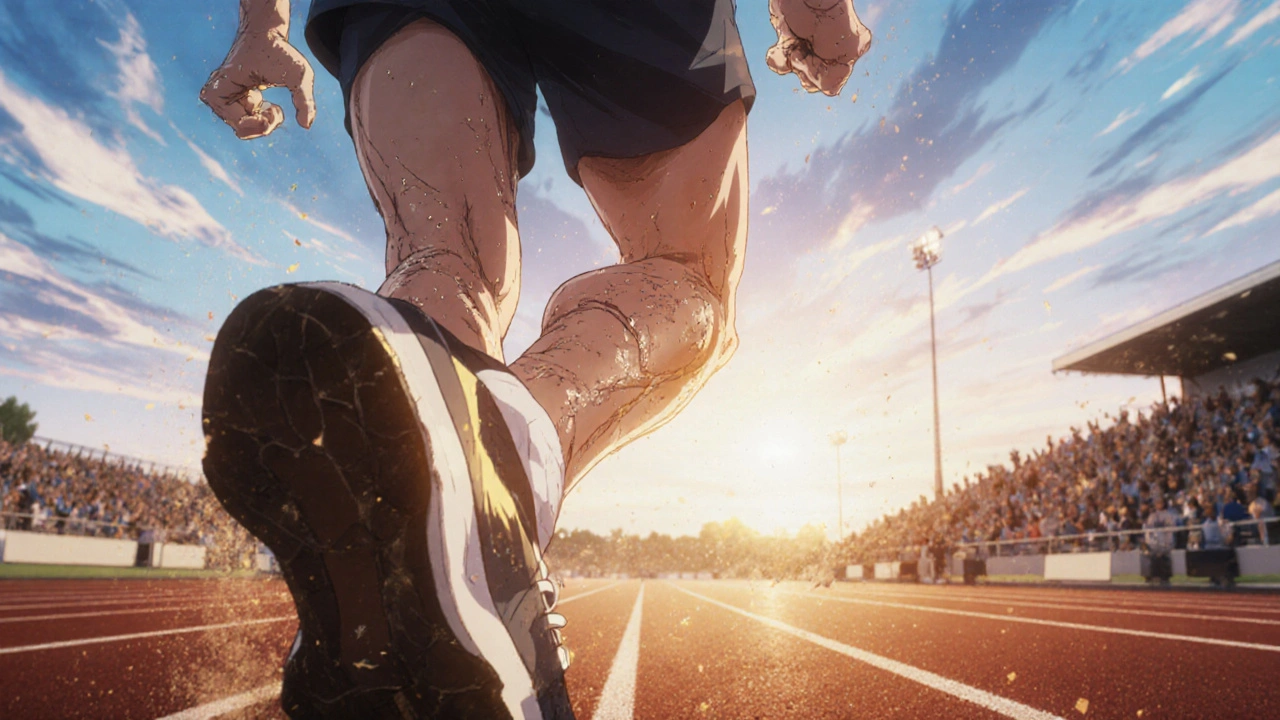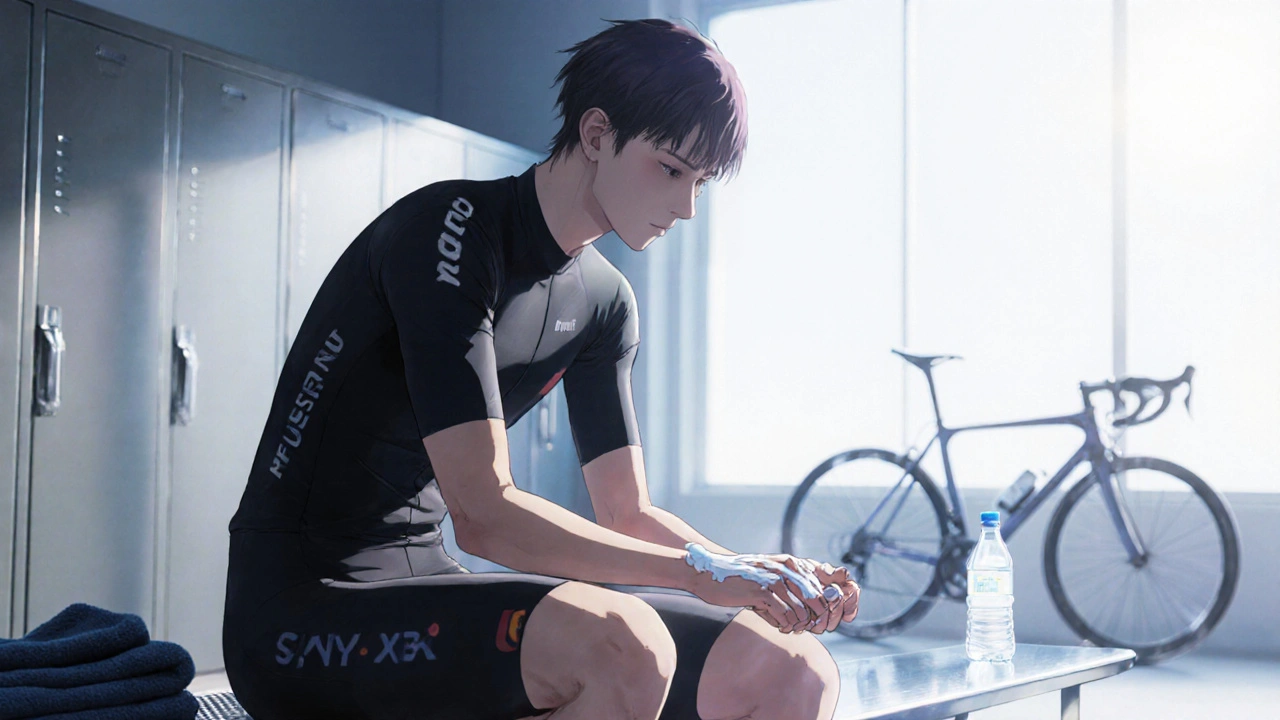How Athletes Can Prevent and Treat Chapped Skin

Chapped Skin Prevention Calculator
Personalized Moisturizer Guide
Select your sport, environment, and activity duration to get tailored recommendations for preventing chapped skin.
When a runner, cyclist, or swimmer feels that tight, flaky sensation on their hands, feet, or face, they’re dealing with chapped skin. For athletes, this isn’t just a cosmetic nuisance-it can impair grip, cause pain, and even lead to infection. Below you’ll find practical ways to stop the cracking before it starts and fast‑acting fixes when it does.
Key Takeaways
- Identify the three main triggers: sweat, friction, and environmental exposure.
- Follow a three‑step daily routine: cleanse gently, seal with a barrier, and re‑apply after activity.
- Choose moisturizers with petrolatum, glycerin, or hyaluronic acid for lasting hydration.
- Adjust equipment and clothing to reduce friction and manage moisture.
- Watch for warning signs that need medical attention, such as bleeding or infection.
Understanding the Enemy: What Causes Chapped Skin in Athletes?
Chapped skin is a condition where the outer layer of the epidermis loses moisture, becomes rough, and may develop tiny cracks. The loss of the skin’s natural barrier is usually driven by three forces that are amplified during sport:
- Sweat - water evaporates, pulling lipids away from the skin.
- Friction - repetitive contact with equipment, shoes, or clothing creates micro‑tears.
- Environmental exposure - wind, cold, sun, and low humidity strip moisture even faster.
When these factors combine, the skin’s protective lipids break down, leaving it vulnerable to cracking and infection.
Who’s at Risk? Athletes Most Prone to Skin Cracking
Athletes who engage in high‑intensity or long‑duration activities are the biggest sufferers. Endurance runners, triathletes, basketball players, rock climbers, and swimmers report the highest rates because their skin endures constant moisture and friction.
Even indoor athletes-like weightlifters-can get chapped hands from grip‑enhancing chalk or repeated bar contact. The common thread is any sport that forces the skin to work harder than in everyday life.

Prevention: Build a Protective Routine Before, During, and After Exercise
Think of skin care as a three‑phase workout: warm‑up, main set, and cool‑down. Each phase has a simple, evidence‑backed step.
1. Pre‑Exercise: Cleanse and Seal
- Gentle cleanse. Use a pH‑balanced, sulfate‑free body wash. Harsh soaps strip the acid mantle, making skin more susceptible to damage.
- Apply a barrier ointment. Choose a product with petroleum jelly or a blend of petrolatum and dimethicone. These occlusive agents lock in moisture for up to 8 hours.
2. During Exercise: Manage Moisture and Friction
- Wear moisture‑wicking fabrics. Technical synthetics (e.g., polyester‑spandex blends) pull sweat away from skin, reducing the “wet‑and‑rub” effect.
- Use anti‑chafe gear. Apply a thin layer of moisturizer that contains glycerin or hyaluronic acid to high‑friction zones (inner thighs, feet, hands) before lacing up.
- Re‑apply as needed. If you’re training for longer than 90 minutes, wipe the skin with a damp cloth and re‑coat the barrier ointment.
3. Post‑Exercise: Restore and Repair
- Cool‑down shower. Use lukewarm water (not hot) and a mild cleanser to remove sweat residue without over‑drying.
- Deep‑hydrate. Follow with a richer cream that contains hyaluronic acid. This humectant draws water back into the epidermis.
- Nighttime seal. Apply a thick layer of petrolatum before bed. Overnight, the skin repairs its lipid matrix, reducing future cracking.
Choosing the Right Moisturizer: A Quick Comparison
| Ingredient | Occlusivity | Humectancy | Best Use Case |
|---|---|---|---|
| Petrolatum (e.g., Vaseline) | High | Low | Night seal, extreme cold |
| Glycerin Blend | Medium | High | During activity, low‑friction zones |
| Hyaluronic Acid Cream | Medium | Very High | Post‑workout recovery, dry climates |
| Silicone‑Based (Dimethicone) | Medium | Low | High‑sweat sports like swimming |
For most athletes, a two‑step combo works best: a thin glycerin‑based moisturizer before the session, followed by a petrolatum night treatment.
Equipment and Clothing Hacks to Cut Friction
- Proper shoe fit. Shoes that are too tight increase pressure points on the feet, while loose shoes cause toe‑slippage and blistering. Aim for a thumb’s width of space at the toe box.
- Textured gloves. Cyclists and weightlifters often use leather gloves with a pre‑applied skin‑protective liner. The leather spreads pressure and reduces sweat buildup.
- Anti‑chafe sticks. Products like BodyGlide create a slick barrier on high‑friction areas such as inner thighs and underarms.
- Layered socks. A moisture‑wicking base (synthetic) plus a cushioned outer sock reduces foot friction during long runs.

When to Seek Professional Help
Most minor cracks heal with the routine above, but watch for red flags:
- Bleeding that won’t stop after 10 minutes.
- Signs of infection: increasing redness, warmth, pus, or fever.
- Persistent pain that interferes with training.
If any of these appear, see a dermatologist or sports medicine clinician. They may prescribe a topical steroid or an antimicrobial ointment.
Quick Checklist for Every Athlete
- Wash with a mild, sulfate‑free cleanser before training.
- Apply an occlusive barrier (petrolatum) to high‑risk areas.
- Dress in moisture‑wicking, seamless fabrics.
- Re‑apply a thin glycerin‑based moisturizer every 60‑90 minutes.
- Shower with lukewarm water post‑session and use a hyaluronic‑acid cream.
- Nightly, seal with a thick layer of petroleum jelly.
- Inspect skin daily for cracks, bleeding, or infection.
Frequently Asked Questions
Can I use regular hand lotion for chapped skin?
Ordinary hand lotions often contain alcohol or fragrance, which can worsen dryness. Choose a fragrance‑free product with petrolatum, glycerin, or hyaluronic acid for the best protection.
How often should I re‑apply moisturizer during a marathon?
Aim for a quick re‑application every 60-90 minutes, especially on the hands, feet, and any areas that rub against clothing or gear.
Is sunscreen necessary for preventing chapped skin?
Yes. UV rays damage the skin’s lipid barrier, making it easier for sweat to strip moisture. Use a broad‑spectrum SPF 30+ on exposed skin before outdoor training.
Can diet affect skin hydration for athletes?
Adequate water intake is crucial, but electrolytes like sodium and potassium help retain that water at the cellular level. Include a balanced electrolyte drink post‑workout to support skin recovery.
What’s the difference between a moisturizer and an ointment?
Moisturizers (creams, lotions) contain water and humectants, providing quick relief. Ointments are oil‑based, forming a thicker occlusive layer that locks moisture for longer periods.
Should I avoid chalk on my hands if I’m prone to chapped skin?
Chalk can dry out skin, but it also reduces slippage. If you need chalk, apply a thin layer of moisturizer underneath, then dust chalk on top. This sandwich technique balances grip and hydration.
By understanding why chapped skin happens and following a simple, sport‑specific care plan, you can keep your skin resilient, your performance steady, and your confidence high-no matter how hard you push yourself.
Gary Marks
October 22, 2025 AT 13:43Man, you think you’ve got this whole athlete skin thing nailed down and then-bam-your hands crack like dry twigs in a desert storm, and it just drives me insane. First off, the whole “sweat is the enemy” nonsense is a lazy excuse; sweat is natural, it’s the lack of a proper barrier that turns it into a nightmare. You’re out there pounding the pavement, dripping like a faucet, and you forget to slap on that occlusive jam before you even lace your shoes. Then you waltz into the gym, chalk your hands to the point they look like they’ve been through a sandstorm, and wonder why they peel like paint. The friction from your gear is a silent assassin, creeping up on you while you’re busy counting reps. And don’t even get me started on those “environmental exposure” warnings that sound like a conspiracy theory cocktail-yeah, wind and cold will mess with you, but only if you’re not protecting yourself. You need a three‑step routine that reads like a military operation: cleanse, seal, re‑apply, repeat, repeat, repeat. Use a pH‑balanced cleanser, then slather on petroleum jelly like you’re greasing a bike chain-don’t be stingy. While you’re grinding, keep a small squeeze bottle of glycerin‑based cream in your pocket; it’s your lifeline. If you’re running a marathon, wipe a damp cloth on your calves every hour and re‑coat that barrier-otherwise you’ll end up with a skin desert that even a camel would avoid. Post‑workout, forget the hot shower; lukewarm water is your friend, not a steam room. Follow up with a hyaluronic acid cream that actually pulls water back into the skin, not just a scented perfume. At night, coat your cracked spots in a thick layer of Vaseline and let your body do the healing behind the scenes. And if you ever see blood that won’t quit or a red patch that spreads like gossip, don’t play hero-see a dermatologist before you turn into a walking infection. Bottom line: treat your skin like a prized piece of equipment, not an afterthought, and you’ll keep crushing those miles without looking like a ghost.
Steven Young
October 24, 2025 AT 07:23Honestly the piece reads like a corporate health pamphlet written by someone who never sweats a drop in their life. It glosses over the fact that many manufacturers push products with hidden chemicals that actually strip skin further. You trust the brand name but the occlusive agents can be a front for micro‑plastics that are harmful in the long run. The author fails to mention the role of diet and systemic inflammation in skin health which is a glaring omission. Skipping that part is not an accident; it’s a deliberate distraction from the real agenda.
Kelly Brammer
October 25, 2025 AT 19:29This guide, while thorough, overlooks the moral responsibility athletes have to set an example for younger competitors. It’s not enough to simply treat your own skin; you must advocate for clean, non‑toxic products and educate teammates about the dangers of quick‑fix chemicals. Encouraging a culture of transparency and ethical product selection is essential if we truly care about the well‑being of our sporting community.
Craig E
October 27, 2025 AT 04:49When we consider the body as an intricate system, the skin emerges as a philosophical frontier-an interface between self and environment. Treating it merely as a mechanical barrier reduces the richness of the experience of sport. By nurturing it with mindful rituals, athletes can engage in a meditative practice that aligns the body’s outermost layer with inner intention, forging a deeper connection between effort and embodiment.
Caleb Clark
October 28, 2025 AT 11:23Hey team, listen up! If you wanna keep crushing it without those nasty cracks slowing you down, follow this simple game plan. First thing, start each session with a gentle cleanse-no harsh soaps that strip away those good oils. Then slap on a thin layer of a glycerin‑based cream, that stuff is like a water magnet for your skin. During the long workouts, keep a pocket bottle of that same cream and re‑apply every hour, especially on your hands and feet, you’ll thank me later! After you finish, take a lukewarm shower, ditch the hot water-you don’t want to dry out the skin further. Finish with a richer hyaluronic acid cream and seal it with petroleum jelly before bed. Trust me, this routine will keep your skin happy and your performance on point. Keep grinding and stay protected!
Sireesh Kumar
October 29, 2025 AT 15:09Alright folks, let me drop some knowledge bombs here. You think a simple lotion can solve everything? Nope. The real secret is in the combo-glycerin for the instant moisture pull, and then that thick petrolatum barrier to lock it in like a vault. And don’t forget the electrolytes, they’re basically the unsung heroes that help your skin retain that water you drink. If you skip the post‑workout electrolyte drink, you’re basically asking for dry skin. So, drink up, slather up, and keep those cracks at bay.
Eileen Peck
October 30, 2025 AT 16:09Great points! Just a quick tip‑?make sure your socks have a seamless toe to avoid extra friction – it really helps prevent foot cracks. Also, a tiny bit of petroleum jelly on your elbows before a long swim can stop those dry patches. Hope that helps!
Oliver Johnson
October 31, 2025 AT 14:23Honestly, all this “use fancy creams” nonsense is just a way to make us buy more stuff. Real athletes rely on good old sweat and grit, not some gimmick ointments. If you’re not willing to tough it out, maybe you’re not cut out for real competition.
Taylor Haven
November 1, 2025 AT 09:49While I appreciate the attempt at a comprehensive guide, it’s glaringly obvious that the author has neglected the deeper societal implications of promoting consumerist skin‑care routines. By encouraging athletes to purchase multiple premium products, we are inadvertently supporting a capitalist agenda that preys on insecurities, turning a natural physiological response into a marketable problem. This not only diverts attention from the importance of holistic health-such as balanced nutrition, adequate rest, and mental well‑being-but also fuels a cycle where individuals feel compelled to consume ever‑increasing quantities of commercial ointments. The underlying message is clear: our bodies are merely vessels for profit, and any deviation from this narrative is dismissed as ignorance.
Vandermolen Willis
November 2, 2025 AT 02:29Great tips 👍
Kelli Benedik
November 2, 2025 AT 16:23Wow, this article is 🔥 but you totally missed the point about the *psychological* impact of cracked skin on confidence-like, imagine stepping onto the track feeling self‑conscious because your hands look like they’re about to fall off. Also, sprinkle in some emojis for flair next time, it'll make the guide more relatable!! 😅💪
Marrisa Moccasin
November 3, 2025 AT 03:29Wow!!!, this guide, while seemingly helpful, completely ignores the hidden agenda behind these so‑called "advanced" moisturizers!!!, the additives, the undisclosed micro‑plastics-everything!!!, it's a corporate trap!!!, we must stay vigilant!!!, question every ingredient!!!, demand transparency!!!
Jonathan Harmeling
November 3, 2025 AT 11:49Interesting read, though I think the emphasis on petroleum jelly a bit overstated-some athletes manage just fine with natural oils and still stay injury‑free. It might be worth exploring alternative options for those who prefer a more minimalist approach.